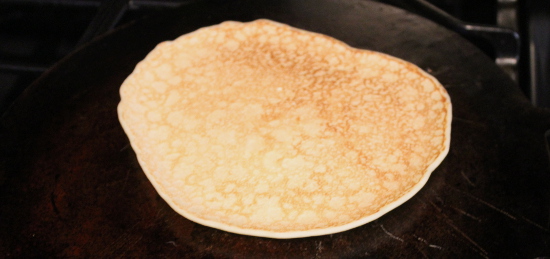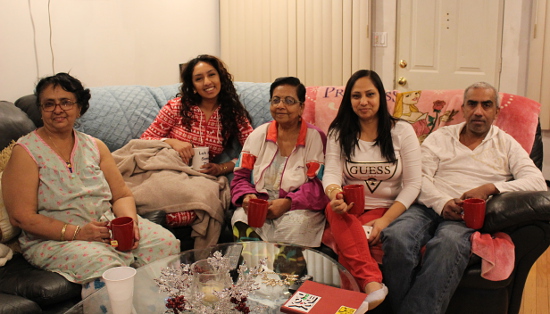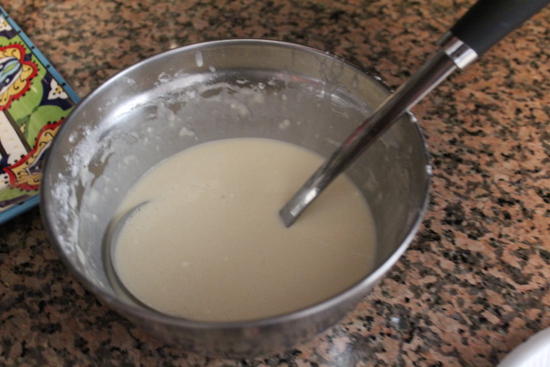The difference between tea and life back home and over here, according to a Guyanese-American family in South Ozone Park.

March 10, 2016
“Back home everybody take sugar and everybody take milk. It’s only over here people come and don’t use as much sugar,” Rebena Lal said, setting off a family conversation about the right cup of tea.
“Well because we diabetic over here,” Tatpati Lal, her mother-in-law, interrupted.
“Yes, but we’re talking about back home breakfast now,” Rebena quipped.
I sat down with the Lal family in their South Ozone Park home before the holidays to discuss all things tea, specifically the Guyanese cup of tea. Everyone was lounging in the living room as the Miss Universe pageant unfolded quietly in the background.
The family has lived in South Ozone Park since Rebena and Mark migrated to New York from Guyana in the 90s. Rebena has worked for an insurance and travel agency for seven years. Her husband, Mark, works as a supervisor and foreman for an interior decorating company in Manhattan. He has been with the company for 15 years that Rebena jokes that he is basically married to his job. They have one daughter, Ashley, a college student studying criminal justice at John Jay College.
Spending time together as a family is important to the Lals, especially with everyone’s busy schedule. For the evening I feel like I am also part of their family.
Before I began the interview in earnest, Rebena reminded Ashley to let her know when Miss Guyana makes an appearance in the pageant. But tea proved to be a hot topic for the family and soon the applause from the television was drowned out by everyone’s energetic voices.
“It’s a normal thing for us from since back home that most Indians do. In the morning everybody have a cup of tea,” Rebena said.

The invocation of ‘back home’ transforms the warm living room into a Guyana I do not know, but long to.
“I don’t take tea in the day. Morning: coffee. In the evening: tea,” Rebena’s mother, Canaza Ramon, said.
“But for back home it was different. Back home does be mostly morning and afternoon,” Rebena reminded her.
The conversation shifted fluidly between tea drinking back home and over here. Back home refers to Guyana and over here, in this case, to New York. Any gyaff session with Guyanese relatives and friends is peppered with these words: back home and over here. The past is parceled up neatly, the myriad differences (and sometimes similarities) between life abroad and life as it was lived in Guyana apparent. Sometimes the words carry the weight of nostalgia and loss. Other times they signify uplift and better living.
“Memories of the Guyanese snackette or a fluffy piece of chota with cashew jam provide an entry point into the Indian, Creole, African, and British influence on Guyana’s cuisine and eating habits.”
Guyanese love to chat. To gyaff. A good gyaffin’ can be about something as mundane as the color of someone’s roof. It can be the latest gossip about someone’s aunty’s sister’s son who lives in England.
Gyaffing happens everywhere. On Liberty Avenue when you run into a distant relative and end up talking on the sidewalk for half an hour; on the A train when someone says you resemble a friend of theirs; at wedding ceremonies, backyard jams, and funerals. In the kitchen, on the front stoop, on the phone. The anatomy of a gyaff session only requires a few chatty bodies, some laughter, and an extended period of time.
“For me, I don’t drink tea everyday. It’s maybe four times a week for me,” Ashley, 21, told me. Coffee is Ashley’s go-to drink for everyday functioning. A cup of tea, she told me, is all about winding down and relaxing after a busy day.
The conversation was pulled back to the past, to what makes a ‘back home’ cup of tea.
Mark and Tatpati rarely used pasteurized milk as they had cows, but Caneza remembered using “tin” (condensed) milk most of the time.

“Somebody used to come and bring milk every morning in Wakenaam. She used to scald the milk and then use it for the tea,” Rebena says.
Wakenaam is a small island situated near the Essequibo River in Guyana. Its name means “waiting for a name” in Dutch. There are multiple villages on the island and it is where Rebena grew up with her mom, dad and siblings.
“Most mornings mom made pancakes. Back home they does call it chota. Chota with eggs. Over here it’s called pancakes,” Rebena explained.
Caneza would make fresh cherry, guava, cashew or five finger jam when the fruits were in season to eat with it. I grew up eating chota roti, too. It carries a mild taste with a hint of sweetness. It’s not quite as fluffy as a pancake and a bit dense. In Hindi, ‘chota’ means small. I wondered if it is a version of South Indian dosa, a direct link to our indentured past, or if it really just is a pancake.
“Some morning it’s slice bread and butter or fry egg and slice bread,” Caneza added.
“If you talking about Guyana and not here, a lot of people go to the snackette and they have maybe a mauby and an egg ball or a mauby and a puri with mango sour. That’s actually people on a regular work schedule,” Mark piped in.
Snackettes are small food stalls workers on-the-go frequent for a quick meal, Guyana’s version of the New York coffee push cart. Instead of bagels and coffee, one can have a more savory snack with a mauby. Mauby is enjoyed across the Caribbean. It is a refreshing drink with a bitter aftertaste and brewed from a specific tree bark, Colubrina elliptica. Puri is a type of unleavened bread that is deep fried and usually eaten with curry.
Memories of the Guyanese snackette or a fluffy piece of chota with cashew jam provide an entry point into the Indian, Creole, African, and British influence on Guyana’s cuisine and eating habits. Egg balls, for example, are a Guyanese version of scotch eggs. The only difference is that the deep fried egg is wrapped in cassava instead of meat and served with mango sour.
“But best of all we like we roti and curry in the morning,” Mark says laughing.

Canadian tea brand Red Rose was a favorite of Caneza’s, but there was a time Tatpati remembers it was only available on the black market after Guyana’s independence and subsequent dictatorial rule by President Forbes Burnham. But black tea was not the only tea enjoyed.
“A lot of countryside people used the bush tea,” Rebena remembered.
Herbal teas such as lime leaf tea, sweet broom, and fever grass are just a few varieties that grow wild in the country and are often used as herbal remedies for sickness and disease.
“Over here, fever grass is called lemon grass, but it’s more expensive here,” Mark said.
Fever grass is found across Guyana and can be used as a remedy for many ailments or as a lemon flavoring for tea. According to WebMD, fever grass can be used to treat high blood pressure, fever, digestive problems, and high blood pressure.
“Back home you can just plant it,” Tatpati said.
“’Another thing about back home is that instead of making an individual cup for everybody in the house, mommy would make one pot with two spoons of tea and a dash of cinnamon. That’s really different compared to now. Everybody into their individual tastes over here,’ she said.”
“We used to parch we own coffee beans. We had our own coffee growing. Pick them, dry them, parch and grind them ourselves – that’s fully organic. Real organic. Those trees just grow themselves,” Mark reminisced.
The conversation moved to their thoughts on chai. Rebena and Ashley would enjoy a cup of chai whenever they went to Bombay Theater to catch the latest Bollywood flick.
“But now they give you the tea bag alone! All they do is drop the damn tea bag in the cup,” Rebena said laughing.
Dunkin Donuts’ vanilla chai is deemed entirely too sweet and rich to be enjoyed on a daily basis, but Rebena admitted she’ll dash a bit of cinnamon in her tea now, a small reminder of back home.
Little things are different over here: a tea bag and condensed milk are substituted for loose tea and scalded milk. There is no cinnamon tree in the Lal’s front yard to harvest fresh bark from. But, there is another difference that anyone who has left their ‘back home’ for ‘over here’ can relate to.
“Another thing about back home is that instead of making an individual cup for everybody in the house, mommy would make one pot with two spoons of tea and a dash of cinnamon. That’s really different compared to now. Everybody into their individual tastes over here,” she said.
“That’s because everybody is not eating together,” Mark reminded her.
“Guyana lifestyle and American lifestyle is different,” Tatpati added.



